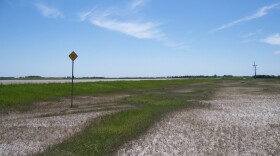A friend recently told me all about the Baltimore orioles they had been observing, complete with a cell phone picture of the oriole feeding on a half an orange at their feeder.
Most everyone is familiar with the Baltimore oriole, but it might surprise you that North Dakota has three species of orioles. The Baltimore oriole and the orchard oriole range over much of the state. The orchard oriole is darker with the orange being less prominent. The bullock’s oriole may be found southwest of the Missouri River. It is a chunkier oriole with brighter coloration, and unlike the Baltimore oriole which has a dark head, the bullocks head is orange with a black cap and eye stripe.
Baltimore orioles utilize habits of open woodland and small groves of trees, as well as parks, backyards, and the like. It is interesting to note that one of their winter habitats are the coffee and cacao plantations of Central America.
Ornithologist Arthur Cleveland Bent described the song of the Baltimore oriole in his Life Histories of Familiar North American Birds as “the softest, sweetest voice of all our birds.” The oriole’s song is somewhat reminiscent to that of a robin but more liquid, sweet, and pure.
And of course, who among us has not been intrigued by the sight of an oriole nest! How do they make their hanging basket-nest of various fibric materials? That material may include such things as grasses, hair, wool, string, thread, twine, and the like. It seems like nimble fingers and an opposable thumb and well-developed brain would be prerequisites for such a construction.
No doubt many among us think that the Baltimore oriole is named after the city in Maryland. However, Cornell University’s All About Birds website notes the Baltimore oriole is so named because the coloration of the oriole, bright orange and black, is similar to the coloration of the England’s Baltimore family crest.
So be on the lookout for Baltimore orioles in your area. And keep your ears open to their interesting song. And if you really want to see and hear them, put out a nectar feeder, half an orange, and some grape jelly. You will be richly rewarded.




